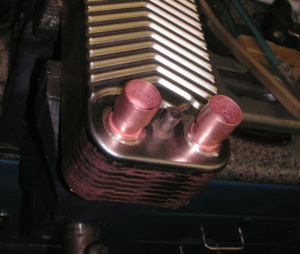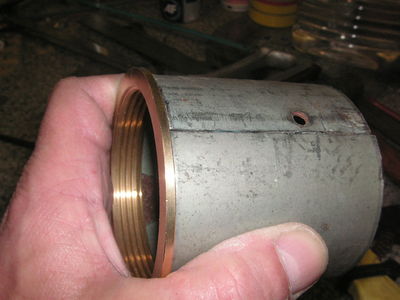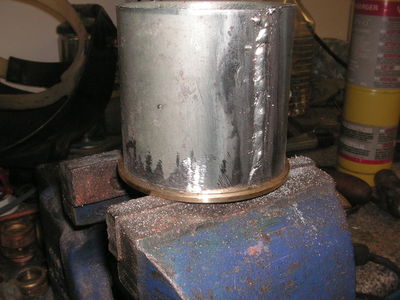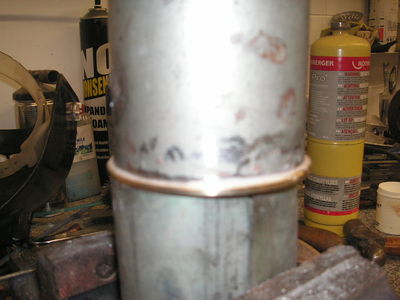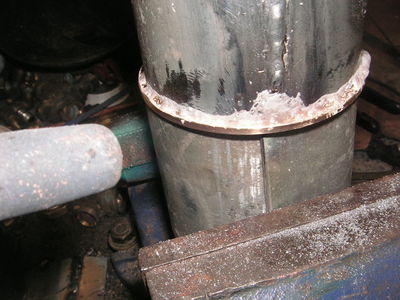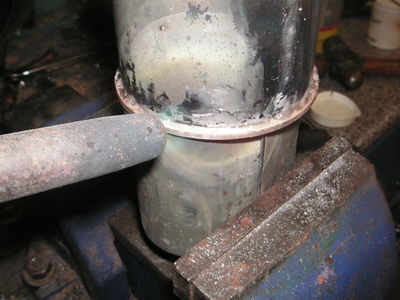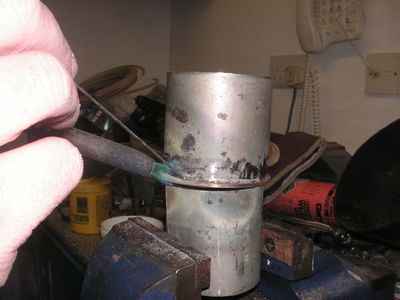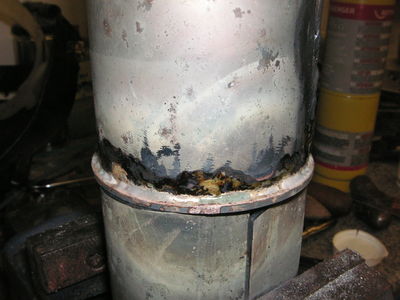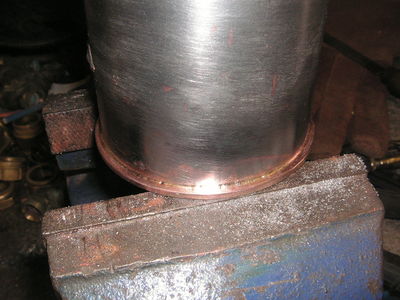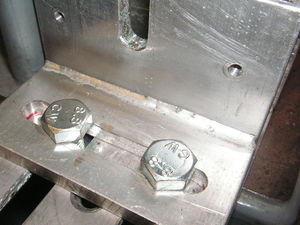Difference between revisions of "Silver soldering"
(→Aluminium torch brazing) |
|||
| (5 intermediate revisions by the same user not shown) | |||
| Line 1: | Line 1: | ||
| + | ==Brazing techniques - General== | ||
| + | |||
| + | Brazing is a similar process to soldering, allowing metallic parts to be joined permanently by flowing in an alloy with a lower melting point than the parts to be joined. The molten alloy in turn alloys with the hot substrate, forming an extremely strong bond. Most brazing processes exhibit a degree of capillary action, having the ability to "wick" into joints and form a large fused area while presenting a minimal bead profile outside the joint. | ||
[[File:Silver_soldered_pipe_connections_on_a_FPHE.png|300px|thumb|right|Copper pipe connections silver soldered to a FPHE.]] | [[File:Silver_soldered_pipe_connections_on_a_FPHE.png|300px|thumb|right|Copper pipe connections silver soldered to a FPHE.]] | ||
| + | __TOC__ | ||
| − | |||
| − | |||
| − | |||
| − | |||
| − | |||
==Silver soldering or hard soldering== | ==Silver soldering or hard soldering== | ||
| Line 27: | Line 26: | ||
Silver soldering may be used to join copper, brass, iron, steel, high-speed steel and (with a special flux) stainless steel. | Silver soldering may be used to join copper, brass, iron, steel, high-speed steel and (with a special flux) stainless steel. | ||
| + | |||
| + | |||
| + | <gallery caption="Silver soldering sequence" widths="400px" heights="300px" perrow="2" align="center"> | ||
| + | File:Heater_flange_and_tube.JPG|Components fabricated, ready for assembly. | ||
| + | File:Preparation for silver soldering.JPG|Joint cleaned and ready for silver soldering. Materials, steel and brass. | ||
| + | File:Flux_mixed_into_paste_and_applied_to_joint.JPG|Powdered flux is mixed with water to a paste and applied to the joint. | ||
| + | File:Heat applied flux foams and solidifies.JPG|When heat is applied, the flux foams and solidifies. | ||
| + | File:Flux liquefies and runs.JPG|With additional heat, the flux liquefies and runs into the joint. | ||
| + | File:Silver solder applied.JPG|Once the flux is completely liquid, the silver solder is applied. Only a small amount is needed. | ||
| + | File:Silver solder runs around joint.JPG|If heated throughly, the silver solder should run all round the joint from only a few touches with the rod. | ||
| + | File:Completed joint after cleaning.JPG|Finished joint after cleaning. Note how little silver solder is required for a satisfactory joint. | ||
| + | </gallery> | ||
| + | |||
==Classic brazing== | ==Classic brazing== | ||
| Line 51: | Line 63: | ||
==Aluminium torch brazing== | ==Aluminium torch brazing== | ||
| + | [[File:Alibrazing.JPG|300px|thumb|right|An example of aluminium brazing done with a MAPP gas torch and fluxless rods.]] | ||
Brazing aluminium is a superficially similar to the processes mentioned above, but different in several very important ways. | Brazing aluminium is a superficially similar to the processes mentioned above, but different in several very important ways. | ||
| Line 75: | Line 88: | ||
| − | + | ==See also== | |
| − | See also | ||
| − | |||
| − | |||
| − | |||
| − | |||
| − | |||
| − | |||
| − | |||
| − | |||
| − | |||
| − | |||
| − | |||
| − | |||
| − | |||
| − | |||
| − | |||
| − | |||
| − | |||
| − | |||
| − | |||
| − | |||
| − | |||
| − | |||
| − | |||
| − | |||
| − | |||
| − | + | * [[Soldering]] | |
| − | |||
| − | |||
| − | |||
[[User:Mr Cat|Mr Cat]] 05:22, 24 January 2011 (UTC) Mr Cat, 24th January 2011 | [[User:Mr Cat|Mr Cat]] 05:22, 24 January 2011 (UTC) Mr Cat, 24th January 2011 | ||
Latest revision as of 23:43, 8 July 2011
Brazing techniques - General
Brazing is a similar process to soldering, allowing metallic parts to be joined permanently by flowing in an alloy with a lower melting point than the parts to be joined. The molten alloy in turn alloys with the hot substrate, forming an extremely strong bond. Most brazing processes exhibit a degree of capillary action, having the ability to "wick" into joints and form a large fused area while presenting a minimal bead profile outside the joint.
Contents
Silver soldering or hard soldering
Silver soldering is a rewarding process using a filler metal with a high silver content (up to 40%). The silver alloy allows relatively low temperature use at approximately 700 degrees C, rapid wetting of the components and an excellent capillary action. It is highly fluid and makes joints quickly, but will not easy fill gaps. It is obviously expensive. For this reason it is most suitable to smaller, more delicate work, or premium work where effective jointing is mission-critical. Work as small as spectacle frames can be brazed with a little practice but much larger joints can be made with enough heat.
Silver solder is sold in individual strips costing around £5 for 9 grams. Easy-flo flux is sold in a variety of tub sizes starting at around £5 for 100 grams. For occasional use, this much will last a long time.
The work must be cleaned to a high standard before jointing by complete degreasing. All oxides and scales must be removed by abrasion or pickling. A rough surface is not necessary as the silver solder will alloy with the base metal regardless of surface finish. There should be minimal clearance between parts.
The flux to be used is supplied as a white powder, and is mixed to a paste with clean water before use. This paste is applied to the joint while the metal is cold. Be generous with the flux. A popular and well-understood brand is Easy-Flo brazing flux, available widely.
The work should be warmed gently for a time to allow the flux to dry, before increasing power and heating the work to a bright red heat. The solidified flux will blacken, then melt and flow to a clear liquid. introduce the filler rod quickly to prevent it melting off in the flame - this is far too easy. It should melt quickly and flow into the joint rather like ordinary solder.
If the joint relies on a deep capillary joint, keep the heat on it and if possible check the distant end of the joint to make sure the solder has penetrated throughout. Add more solder quickly if needed.
When the joint is complete remove the heat and allow to cool. Excess flux can be removed by scrubbing with hot water. The rest of the work will be tarnished by the high temperatures involved but can be bought back to a good finish by pickling or abrading with wire wool, wire brushes etc.
Silver soldering may be used to join copper, brass, iron, steel, high-speed steel and (with a special flux) stainless steel.
- Silver soldering sequence
Classic brazing
Actual brazing is conducted at higher temperatures than silver-soldering (over 800 degrees C) and uses a brass alloy (copper/zinc) as a filler. This process makes strong joints, but is not as neat as silver soldering. Naturally the filler rods are much cheaper than silver solder, and are usually sold in 5kg packs like TIG rods. Easy-flow flux can be used. The brass filler rod is not as fluid as silver solder and will not leave such a neat finish, however joints of excellent strength may be made in steel (including high speed steel), cast iron and copper. Since the melting point of most brass alloys is close to that of the filler rod caution is advised when jointing brass.
The appearance of a brazed joint is a yellow fillet of metal between the joined parts, the filler metal having a rough finish.
Flux-coated brazing rods are available with similar benefits to coated silver solder rods.
Braze welding or bronzewelding
Bronzewelding is a technique similar to brazing, but using no flux. The filler metal is a bronze alloy (copper/tin). Joints of excellent strength may be made against copper, steel and cast iron. Brass may be joined, provided its melting point is well above that of the filler material - use caution.
The technique employed in bronzewelding is similar to that of oxyacetylene welding, first tacking a joint to stabilise it, then moving a melt pool along the joint, adding filler as the pool moves. The base metal should not be actually melted.
The appearance of a bronzewelded joint is of a fine, smooth joint with a shape and finish equal to that of a silver-soldered joint having a copper-like colour. It looks lovely on copper pipework.
Heating techniques
Silver soldering is best done by heating the whole workpiece using a propane torch as it allows steady, consistent heating. For brazing and bronzewelding, higher temperatures must be employed and it may not be possible to reach these temperatures using a propane torch. An oxy-acetylene torch with a large tip is a useful heat source for brazing, either with a large welding tip or a cutting head with the cutting jet disabled. A welding tip is used for bronzewelding.
Aluminium torch brazing
Brazing aluminium is a superficially similar to the processes mentioned above, but different in several very important ways.
The temperatures employed are very much lower (around 300 degrees C) so propane torches aremost suitable. Since the workpiece does not become red hot, judging temperature is much harder. The filler rod melts at only fractionally below the melting point of most aluminium alloys, making temperature control and torch technique absolutely critical. The flux is highly corrosive and must be removed completely immediately after brazing. Cleanliness is critical - the joint must be completely degreased, and abrasion to disrupt the oxide layer is essential. The molten filler is highly mobile and has excellent capillary action.
The flux, avaialable from BOC and other suppliers, is again a white powder mixed to a paste with water. It melts, then blackens when it is at the right temperature to melt the filler rod.
Technique is similar to that used for silver soldering, bearing the above in mind. Torch control is CRITICAL. Flux can be used as a temperature indicator by placing spots on sections of differing thickness across the workpiece and watching for prematurely rapid blackening - this will give a last-chance warning that that part of the job is about to overheat and collapse. As an additional complicating factor, the flux may burn out if heated for too long. Rapid, accurate heating is required, and requires skill and practice.
Aluminium brazing is difficult to get right, requiring excellent co-ordination and control, but can produce very attractive joints in aluminium of equal strength to a good TIG weld at very low capital cost. It is frequently used on joints too small to weld, or on fine work such as microwave/RF components (ie waveguide joints) and aerospace components.
joints to be brazed may be stabilised by small TIG tack-welds if a TIG welder is avaiable.
Most aluminium brazing fluxes can also be used to weld aluminium using oxyacetylene, although this is a very difficult technique to master.
Aluminium dip brazing
Another form of aluminium brazing, dip brazing is only suitable for commercial use but is included for completeness. The parts to be assembled are built with a thin foil of filler alloy pressed into the joint, stabilised with a TIG welder or mechanical staking then dipped into a bath of molten flux at a precisely controlled temperature. The joint is fluxed and the filler flows out quickly, making the joint. This process was developed for making aicraft radiators during the second world war and persists in this sector, making top quality joints in places completely inaccesible to a welder, and in extremely thin materials. It is particularly suited to heat exchangers, intercoolers etc.
See also
Mr Cat 05:22, 24 January 2011 (UTC) Mr Cat, 24th January 2011
